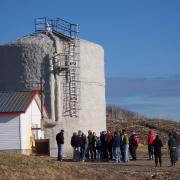![]() Find videos on feedstocks at the Farm Energy Media archive.
Find videos on feedstocks at the Farm Energy Media archive.
![]() Find images of feedstocks at the Farm Energy Media archive.
Find images of feedstocks at the Farm Energy Media archive.
Anaerobic digestion of manure and other feedstocks produces biogas which can be burner to make energy on farms. Learn how to evaluate a feedstock and which ones to exclude for biogas production.
|
|
| Anaerobic Digester in Charlotte, VT. Photo: Caragh Fitzgerald, University of Maine. |




 Harnessing energy from livestock waste.
Harnessing energy from livestock waste. Energy efficiency and conservation are integral to sustainable agriculture. Efficiency means increasing the work or yield per unit of energy; conservation means reducing total energy usage
Energy efficiency and conservation are integral to sustainable agriculture. Efficiency means increasing the work or yield per unit of energy; conservation means reducing total energy usage